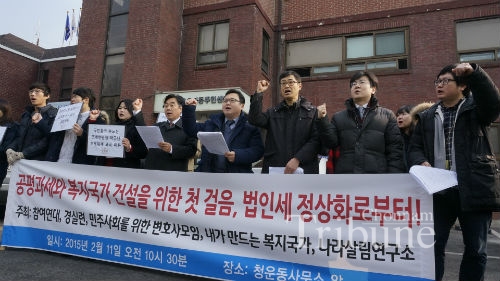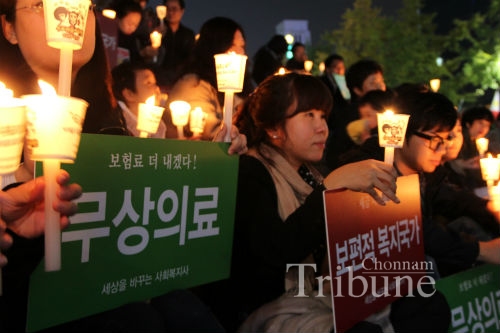①복지국가란?
What are the necessary conditions of your happiness in your life? How many Korean people think that they are now living in a happy society? According to the World Happiness Report 2013, which is published by the Sustainable Development Solutions Network (SDSN), Korea was ranked as the 41st happiest country around the globe, while it ranked the happiest countries, with Denmark, Norway and Sweden (the Scandinavian welfare states) leading the pack. It shows that the Korean happiness rank was not that high considering its economic development level in that it that it was ranked as 13th around the world (on the basis of GDP; IMF, 2014).

From the traditional perspective, people thought that economic growth leads to people’s overall well-being (that is mostly explained by an economical term: trickle-down effect). However, this kind of societal paradigm has become no longer effective because the virtuous circle of economic growth (that is, it tells that economic growth leads to job creation, which in turn, related to higher national overall well-being through increased income and its redistribution) was disrupted. In the past decade, both absolute and relative poverty rates have been rather deteriorated in our society. Furthermore, we are challenged by newly occurring social problems or social risks such as low a birth-rate and a high aging population, and the bi-polarization between the rich and poor, etc.
Therefore, how do we overcome the social problems with which our country is confronted? Transitioning to a sustainable welfare state is a solution for us.
What Is the Welfare State?
Nowadays, welfare states across the globe have not only substantially increased the level of economic protection, but also have generally insured basic levels of well-being to the poor and have remarkably improved the well-being of society’s most vulnerable people. What is the welfare state? The definition of the welfare state was well specified by Asa Briggs’s three goals for the welfare state which are as follows: (1) helping people maintain their economic security when various “social contingencies,” such as unemployment, illness, or old age, make normal self-support impossible; (2) guaranteeing individuals and families a minimum income irrespective of the market value of their property, which makes sure that people achieve at least a minimum level of material sufficiency; (3) ensuring that all citizens without distinction of status or class are offered the best standards available in relation to a certain agreed range of social services, which means helping people secure those fundamental goods and services that society considers essential. Additionally, the issue of a redistribution policy that will be utilized as a measure of socioeconomic equality, needs to be added to the above three goals for the welfare state.

Korea Is a State of 'Low Burden, Low Welfare'
So, can we say that Korea is a welfare state? It is too early to say the county is a welfare state even though there is some argument about it from several perspectives. For example, it’s obvious that Korea’s welfare spending is still not enough by international standards. The percentage of GDP devoted to welfare in Korea remains at about 10.4 percent, less than half the OECD average of 21.6 percent. And Korea’s tax burden is also estimated to be below the OECD average. In sum, Korea is in a state of ‘low burden, low welfare.’
To make a soft-landing the Korean welfare state needs to be established as soon as possible. The question of how to fund it is unavoidable and should be solved at first. For it is expected that its overall socioeconomic condition, such as the low birth-rate and high aging population, family changes, and polarization will make an increase in welfare spending inevitable in future. In the short-term, several measures can be utilized to fund it: (1) minimizing ineffective welfare routines (e.g., welfare fraud, service fragmentation and overlapping, etc.); (2) restructuring the tax system and securing tax justice among all tax-payers (e.g., increasing corporate tax, etc.).
Time to Discuss the 'Korean Welfare State Model'
Of course, it will be impossible that the county can achieve the level of the Scandinavian welfare states (‘high burden and high welfare’) and that will not be our target that we are going to choose for the Korean welfare state model. Past discussions about welfare have been nothing but time-consuming political rhetoric, such ‘free meals and child care,’ and ‘welfare without a tax hike’ in our society. There should be a national consensus on how much welfare we need and how to go about accomplishing it. Specifically, it is time to draw a conclusion about how much people can manage to take as a tax burden and what kind of welfare state model we are going to develop and equip as our sustainable welfare system.
The historically investigated empirical evidence that welfare spending is not any more resource-consuming, but rather is productive can be frequently found across the world countries. It is also noticeable that western welfare states are now changing their previous classic welfare system by incorporating various social investment strategies and activation policies (e.g., hybrid welfare regime). Given the lessons learned from western advanced welfare states, we should also develop our unique welfare state model that reflects our historical and cultural experiences.
By Hwang Jeong-ha, Professor, Dept. of Family Environment and Welfare

